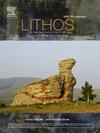Detrital zircon chronology of the Guryong Group, the eastern part of the Gyeonggi Massif, Korea: Implication for the Late Paleozoic pre-collisional evolution in the Korean Peninsula
IF 2.9
2区 地球科学
Q2 GEOCHEMISTRY & GEOPHYSICS
引用次数: 0
Abstract
The tectonic evolution of the Korean Peninsula during the Middle to Late Paleozoic remains a subject of debate due to sparse evidence. The Guryong Group—a metamorphosed sedimentary formation located in the Odesan area of the Gyeonggi Massif—is reported to have been deposited during the Middle Paleozoic and subsequently underwent Permo–Triassic collision-related metamorphism. Therefore, the Guryong Group is crucial for understanding the Paleozoic tectono-thermal history of the region. In this study, we performed comprehensive zircon U-Pb dating and Lu-Hf isotope analysis coupled with geochemical investigations of the metasedimentary rocks of the Guryong Group and its surrounding rocks of the Gyeonggi Massif. Our aim is to determine the timing of deposition and tectonic settings, thereby elucidating the Paleozoic tectono-thermal evolution of the Korean Peninsula. The detrital zircon age distributions in the metasedimentary rocks from the western Guryong Group include clusters of ca. 1899–1616 Ma (8 %), 998–723 Ma (11 %), 537–419 Ma (10 %), and 418–307 Ma (56 %), with the youngest detrital zircons dating between 344 and 307 Ma. In contrast, calc-silicate rocks from the eastern Guryong Group exhibit different age patterns of ca. 1958–1830 Ma (20 %), 1522–1427 Ma (8 %), 1398–1200 Ma (17 %), 1194–1001 Ma (17 %), and 850–720 Ma (23 %), and a main age peak of ca. 749 Ma. Additionally, three biotite gneisses and one quartzite from the eastern Guryong Group show age clusters of ca. 3361–3187 Ma (7 %), 2778–2500 Ma (19 %), 2494–2414 Ma (24 %), 2382–2200 Ma (24 %), 2186–2002 Ma (15 %), and 1927–1826 Ma (6 %), with no Paleozoic detrital zircons. These results suggest that parts of the Guryong Group were deposited at different times from the western part, similar to paragneisses in the Gyeonggi Massif. The newly identified Carboniferous metasedimentary rocks, with the youngest detrital zircons dated to 344–307 Ma, contain 56 % of detrital zircons aged between 418 and 307 Ma. This suggests that Devonian to Carboniferous magmatic rocks were the major source to form the Carboniferous sedimentary rocks of the Guryong Group. The whole-rock chemical analyses of metasedimentary rocks in the western Guryong Group reveal a consistent pattern characterized by enrichment in light rare-earth elements (REEs) and notable depletion in Nb-Ta. The εHf(t) values of zircon grains dated to the Devonian are negative (ranging from −6.67 to −18.13), suggesting that these Devonian magmatic rocks originated from the reworking of the Precambrian basement of the Gyeonggi Massif. This study supports the hypothesis that extensive arc magmatism occurred in the Odesan area during the Devonian to Carboniferous periods prior to the Permo–Triassic continental collision, possibly representing the easternmost extension of Paleozoic arc magmatism occurring along the southern margin of the North China Craton.

求助全文
约1分钟内获得全文
求助全文
来源期刊

Lithos
地学-地球化学与地球物理
CiteScore
6.80
自引率
11.40%
发文量
286
审稿时长
3.5 months
期刊介绍:
Lithos publishes original research papers on the petrology, geochemistry and petrogenesis of igneous and metamorphic rocks. Papers on mineralogy/mineral physics related to petrology and petrogenetic problems are also welcomed.
 求助内容:
求助内容: 应助结果提醒方式:
应助结果提醒方式:


